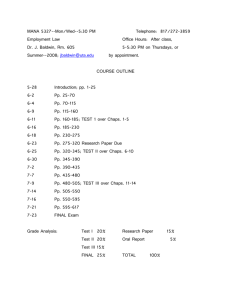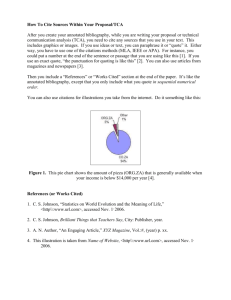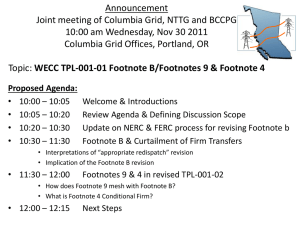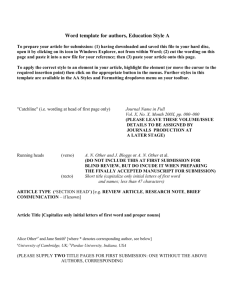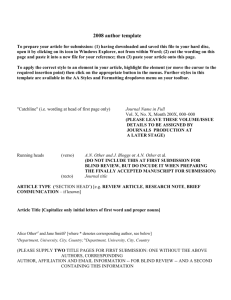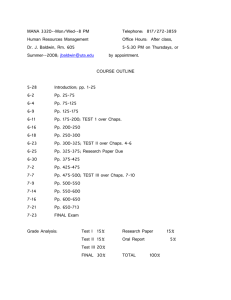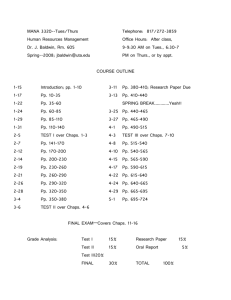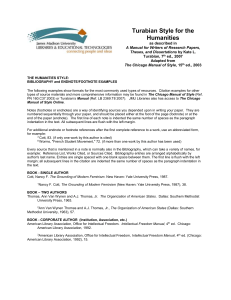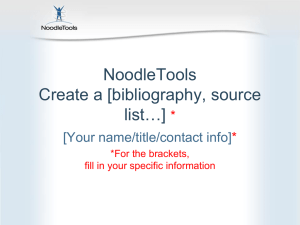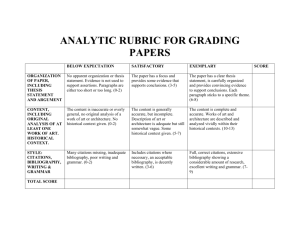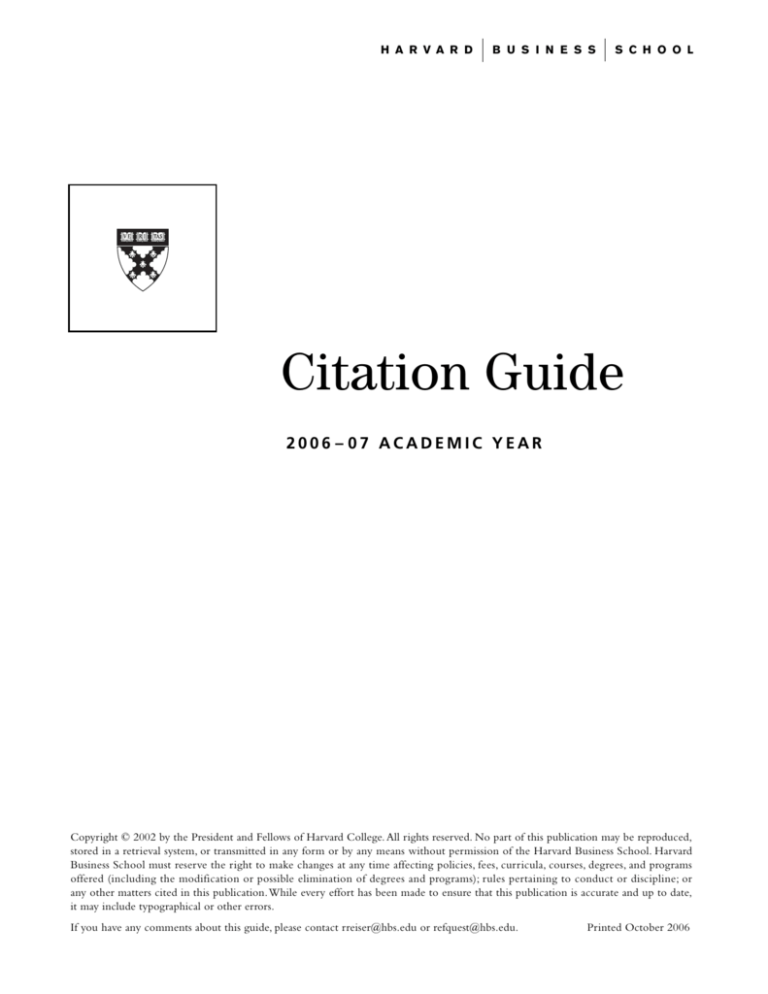
H A R V A R D
B U S I N E S S
S C H O O L
Citation Guide
2006 – 07 ACADEMIC YEAR
Copyright © 2002 by the President and Fellows of Harvard College. All rights reserved. No part of this publication may be reproduced,
stored in a retrieval system, or transmitted in any form or by any means without permission of the Harvard Business School. Harvard
Business School must reserve the right to make changes at any time affecting policies, fees, curricula, courses, degrees, and programs
offered (including the modification or possible elimination of degrees and programs); rules pertaining to conduct or discipline; or
any other matters cited in this publication.While every effort has been made to ensure that this publication is accurate and up to date,
it may include typographical or other errors.
If you have any comments about this guide, please contact rreiser@hbs.edu or refquest@hbs.edu.
Printed October 2006
Table of Contents
About This Guide
Purpose of Citations
What to Cite
4
4
4
Types of Citations: Footnotes, Source Lines, and Bibliographies
5
Footnotes and Endnotes
Source Lines
Bibliographies
Repeating a Citation
5
5
6
6
Ibid.
Shortened Footnote
6
7
Creating New Citation Styles
Permission Requirements
7
7
Examples of Citations
Advertisements
Analyst Reports
Annual Reports (Printed)
Annual Reports (Online)
Articles
Blogs
Bond Prospectuses
Books (Printed)
Books (Online)
Brochures
Cases (Printed)
Cases (Online)
Classroom Discussions
Conference Papers
Databases
E-mail
Government Documents
Interviews
Journals
Legal Cases
Magazines
Marketing Reports
Memorandums
Movies
News Web Sites
Newspapers (Printed)
Newspapers (Online)
Notes
Periodicals (Printed)
8
8
9
9
9
10
10
10
10
13
13
14
14
15
15
16
16
16
18
18
18
19
19
19
19
19
20
20
20
21
Periodicals (Online)
Press Releases
Proceedings
SEC Documents (Printed)
SEC Documents (Online)
Secondary Sources
Slide Presentations
Tables
Technical Notes
Television Programs
Theses and Dissertations
Videos and Multimedia
Weblogs
Web Sites
Working Papers (Printed)
Working Papers (Online)
21
22
22
22
23
24
24
24
25
25
25
25
26
27
27
28
Citations of Commercial Databases
ABI/Inform
Bloomberg
Capital IQ
Compustat
CRSP (Center for Research in Security Prices)
Datastream
Economist Intelligence Unit
Euromonitor
Factiva
Forrester
Gartner
Global Financial Data
Global Market Information Database (GMID)
Hoover’s
I/B/E/S
Investext
ISI Emerging Markets
JSTOR
Jupiter
LexisNexis
OECD (Organisation for Economic Cooperation and Development)
OneSource
Standard & Poor’s (S&P)
SDC (Securities Data Company)
Spectrum
Thomson Research
Venture Economics and Venture Xpert
World Development Indicators and Reports (WDI Online)
29
URLs
34
Endnotes
35
Bibliography
36
29
29
30
30
30
30
30
30
30
30
30
31
31
31
31
31
31
31
31
32
32
32
32
32
33
33
33
33
Citation Guide
> About This Guide
This guide describes the citation conventions that HBS students should use when writing research
papers. The guide has been adapted from Chapter 3 of the Style Guide for HBS Casewriters, which is
available online at http://intranet.hbs.edu/dept/drfd/caseservices/styleguide.pdf. For information
about citing source materials not covered in this guide, please contact rreiser@hbs.edu.
> Purpose of Citations
There are three main reasons to include citations in your papers:
• To give credit to the authors of the source materials you used when writing the paper.
• To enable readers to follow up on the source materials.
• To demonstrate that your paper is well-researched.
There are many ways to document one’s research. The following guidelines, based on The Chicago
Manual of Style, 15th ed., present one method. Whichever method you choose, it is important to
follow a format that is clear and consistent.
> What to Cite
You should cite all direct quotations, paraphrased factual statements, and borrowed ideas. The only
items that do not need to be cited are facts that seem to be common knowledge, such as the date of
the stock market crash. However, if you present facts in someone else’s words, you should cite the
source of those words. In addition, if you paraphrase large amounts of information from one source,
you should cite that source, as emphasized in Harvard University’s Expository Writing guidelines:
When you draw a great deal of information from a single source, you should cite that source
even if the information is common knowledge, since the source (and its particular way of
organizing the information) has made a significant contribution to your paper. 1
Failure to give credit to the words and ideas of an original author is plagiarism. Most people do not
intend to commit plagiarism but may do so inadvertently because they are in a hurry or because
of sloppy work habits. For tips on how to avoid plagiarism, see the following resources:
“How to Avoid High-Risk Situations,” in Gordon Harvey, Writing with Sources:
A Guide for Harvard Students, Expository Writing Program, Harvard University, 1998,
http://www.fas.harvard.edu/~expos/index.cgi?section=resources.
“Working Habits that Work,” in Academic Integrity at Princeton, Princeton University,
http://www.princeton.edu/pr/pub/integrity/pages/habits.html.
“Plagiarism: What It Is and How To Recognize and Avoid It,” in Writing Tutorial Services/
Writing Resources, Indiana University at Bloomington, http://www.indiana.edu/~wts/pamphlets/
plagiarism.shtml.
“HBS Policy in Plagiarism and Collaboration,” on MBA Web site, http://www.mba.hbs.edu/
admin/program/policies/academic/student_work/plagiarism.html.
4
C I TAT I O N G U I D E
> Types of Citations: Footnotes, Source Lines, and Bibliographies
Citations can appear in three main forms: footnotes (or endnotes), source lines, and bibliographies.
Each form contains similar information arranged in a different way. The following sections provide
details about each form.
Footnotes and Endnotes
Footnotes and endnotes have the same function — to cite the exact page of a source you refer to
in your paper. The only difference between footnotes and endnotes is placement: footnotes appear
at the bottom of the page, whereas endnotes appear at the end of the document.
The main characteristics of footnotes and endnotes are as follows:
• They are preceded by a number.
• The author’s name is in natural order.
• The elements of the citation are separated by commas.
The following examples show a quotation and its corresponding footnote or endnote:
Quotation cited in text
Sahlman says,“Taking advantage of arbitrage opportunities is a viable and potentially
profitable way to enter a business.” 32
Corresponding footnote or endnote
32 William A. Sahlman,“How to Write a Great Business Plan,” Harvard Business Review 75
(July–August 1997): 103.
Source Lines
Source lines typically appear under figures, tables, charts, and other graphics. Source lines should
acknowledge the source of the graphic, or the data that was used to create it. A source line begins with
the word Source and continues with the same information that would appear in a footnote or endnote.
The following are some examples of source lines:
Source: Jon F. Thompson, Cycle World, vol. 35, no. 6 (June 1996), p. 23.
Source: “Worldwide Semiconductor Shipments,” Semiconductor Industry Association Web site,
http://www.sia-online.org/downloads/ww_shipments.pdf, accessed June 2004.
Source: Compiled from Bloomberg LP,Thomson Datastream, LexisNexis, and SEC filings data, May 2001.
Source: Casewriter’s diagram based on Rhythms NetConnections, Inc. price data for April 7, 1999
through April 30, 2001, obtained from Thomson Datastream, accessed June 2003.
5
C I TAT I O N G U I D E
Citation Guide for HBS Students – continued
Bibliographies
A bibliography lists all of the references you used to create a research paper. The bibliography
appears at the end of the paper, after the endnotes, if any.
If you have included footnotes (or endnotes) and source lines in your paper, then you do not need
to include a bibliography unless your professor has requested one. Bibliographies typically appear
in documents that use the author-date style of citation, which is not shown here for space reasons.
The following is an example of the author-date style:
Reference in text:
(Calabrese and Loften, 2000)
Bibliography entry:
Calabrese, Edward, and Peter Loften (2000).“The chronic effects of fluoride
on the estuarine amphipods,” Water Research 16:1313-17.
Bibliographies have some special formatting conventions:
• The first author’s name is inverted (last name first), and most elements are separated
by periods.
• Entries have a special indentation style in which all lines but the first are indented.
• Entries are arranged alphabetically by the author’s last name, or by the first word of the title
if no author is listed.
For more information about bibliographies and author-date citations, see chapter 17 in The Chicago
Manual of Style, 15th. ed.
> Repeating a Citation
After the first complete citation of a work, you may abbreviate subsequent instances by using
either Ibid. or a shortened form of the citation. See the following examples of each style.
Ibid.
Use Ibid. to repeat a footnote that appears immediately before the current footnote. Ibid. takes the
place of the author’s name, the title of the work, and as much of the subsequent information as is
identical. For example:
50 Thomas
Smith, “New Debate over Business Records,” The New York Times,
December 31, 1978, sec. 3, p 5.
51 Ibid., p. 6.
6
C I TAT I O N G U I D E
Shortened Footnote
Use the shortened footnote style to repeat a note that is before, but not contiguous to, the
current footnote.
The shortened note should include enough information to help readers identify the source —
i.e., the last name of the author; enough of the title to be clear; and the page number, if different
from the first. For example: 2
1 Samuel A. Morley, Poverty
and Inequality in Latin America: The Impact of Adjustment
and Recovery (Baltimore: Johns Hopkins University Press, 1995), pp. 24–25.
2 [Citation
of different source]
3 Morley, Poverty
and Inequality, p. 43.
> Creating New Citation Styles
If you cannot find an example of the type of source material you want to cite, and if you have
exhausted other resources including The Chicago Manual of Style and rreiser@hbs.edu, then
just try to cite all of the details that would enable a reader to find the source easily. For example:
Author,“Title,” Publication Name, Publication Date, Publication Location and/or URL,
and other relevant details.
The following example shows a citation created by an author who had no example to follow
but who created a citation that was precise and easy to follow:
Clarence Saunders,“Documentary Evidence about Piggly Wiggly,” Harvard pre-1920 social history/
business preservation microfilm project, available from Historical Collections, Baker Library,
Harvard Business School, Microfilm HD Box #136.
> Permission Requirements
If you plan to publish a paper or distribute it widely (e.g., on a Web site), and if the paper contains
the following kinds of information, you may need permission from the copyright holder:
• Graphical items (charts, graphs, maps, photographs, tables, etc.)
• Complete text items (e.g., an entire article)
• Some small excerpts of text or data
Be sure to check the copyright holder’s permission requirements before redistributing any of their
information outside the classroom.
7
C I TAT I O N G U I D E
Examples of Citations
This section shows examples of citations for the most common kinds of source materials.
For information about citing other kinds of materials, see Creating New Citation Syles on p. 7,
or contact rreiser@hbs.edu.
A few notes about the examples:
• The term periodical refers to journals and magazines.
• For brevity, access dates have been shortened to month and year (e.g., June 2003).
• Although Microsoft Word underlines URLs, the URLs in this guide are not underlined.
This matches the standard style for URLs in printed publications and prevents the URLs
from becoming active links. For more information, see URLs on p. 34.
• The following examples appear in alphabetical order, with one exception: When citations are
shown for both printed and online formats, the examples for printed format appear first.
> Advertisements
Television 3
Footnote
1 Volkswagen of America, Inc.,“Crazy Guy,” television advertisement
(Arnold Communications, Inc., directed by Phil Morrison), 2002.
Bibliography
Volkswagen of America, Inc.“Crazy Guy.” Television advertisement.
Arnold Communications, Inc., directed by Phil Morrison, 2002.
On the Web
Footnote
2 Volkswagen of America, Inc., “Crazy Guy,” television advertisement (Arnold
Communications, Inc., directed by Phil Morrison), 2000, http://www.andyawards.
com/winners.2000/last_television3.html, accessed August 2002.
Bibliography
Volkswagen of America, Inc. “Crazy Guy.” Television advertisement.
Arnold Communications, Inc., directed by Phil Morrison, 2002.
http://www.andyawards.com/winners.2000/last_television3.html,
accessed August 2002.
8
C I TAT I O N G U I D E
> Analyst Reports
Signed
Footnote
3 Steve Weinstein,“High Growth in search creates opportunities for niche players,”
Pacific Crest Securities, November 4, 2003, p. 11, http://www.pacific-crest.com,
accessed December 2003.
Unsigned
Footnote
4 Goldman Sachs, Perspectives on the U.S. Restaurant Industry, May 26, 2003.
From a
commercial
database
Footnote
4 Goldman Sachs, Perspectives on the U.S. Restaurant Industry, May 26, 2003,
via Thomson Research/Investext, accessed September 2003.
> Annual Reports (Printed)
Printed
Footnote
3 General Motors, 2001 Annual Report (Detroit: General Motors, 2002), p. 34.
3
General Motors, 2001 Annual Report, p. 34.
Note: Publication details, such as the location and name of publisher, are optional in citations
of annual reports.
> Annual Reports (Online)
On the Web
(company
Web page)
Footnote
4 General Motors, 2001 Annual Report (Detroit: General Motors, 1998), p. 34,
http://www.gm.com/company/investor_information/ financial_data/ar.htm,
accessed June 2002.
On the Web
(database)
Footnote
5 General Motors, 2001 Annual Report (Detroit: General Motors, 2002),
p. 34, via Thomson Research/Investext, accessed May 2003.
9
C I TAT I O N G U I D E
Examples of Citations – continued
> Annual Reports (Online) – continued
CD-ROM
(LaserD)
Footnote
6 General Motors, 2001 Annual Report (Detroit: General Motors, 2002),
p. 34, available from Thomson Financial, Global Access/Laser CD-ROM,
disc no. A2015.
Note: Fixed media such as CD-ROMs do not require an access date.
Bibliography
General Motors. 2001 Annual Report. Detroit: General Motors, 2002.
Available from Thomson Financial, Global Access/Laser CD-ROM, disc no. A2015.
> Articles
See Newspapers and Periodicals.
> Blogs
See Weblogs.
> Bond Prospectuses
Footnote
7 Formula One Finance B.V., August 1999 prospectus for US$1.4 billion of 100%
Secured Floating Rate Notes, due 2010.
Bibliography
Formula One Finance B.V. August 1999 prospectus for US$1.4 billion of 100%
Secured Floating Rate Notes, due 2010.
> Books (Printed)
One author
Footnote
7 David A. Garvin, Operations Strategy: Text and Cases (Englewood Cliffs, NJ:
Prentice-Hall, 1992), p. 73.
Bibliography
Garvin, David A. Operations Strategy: Text and Cases. Englewood Cliffs, NJ:
Prentice-Hall, 1992.
10
C I TAT I O N G U I D E
> Books (Printed) – continued
Two
authors
Footnote
8 John P. Kotter and James L. Heskett, Corporate Culture and Performance
(New York: Free Press, 1992), p. 101.
Bibliography
Kotter, John P., and James L. Heskett. Corporate Culture and Performance.
New York: Free Press, 1992.
Three
authors
Footnote
9 John W. Pratt, Howard Raiffa, and R. O. Schlaifer, Introduction to Statistical
Decision Theory (Cambridge: MIT Press, 1995), p. 45.
Bibliography
Pratt, John W., Howard Raiffa, and R. O. Schlaifer. Introduction to Statistical
Decision Theory. Cambridge: MIT Press, 1995.
More than
three
authors
Footnote
10 F. M. Scherer et al., The Economics of Multi-Plant Operation
(Cambridge: Harvard University Press, 1975), p. 97.
Bibliography
Scherer, F. M.,Alan Beckenstein, Erich Kaufer, R. Dennis Murphy, and
Francine Bougeon-Maassen. The Economics of Multi-Plant Operation.
Cambridge: Harvard University Press, 1975.
Editor
Footnote
11 John J. Gabarro, ed., Managing People and Organizations (Boston: Harvard Business
School Press, 1992), p. 145.
Bibliography
Gabarro, John J., ed. Managing People and Organizations. Boston: Harvard Business
School Press, 1992.
11
C I TAT I O N G U I D E
Examples of Citations – continued
> Books (Printed) – continued
Multiple
editors
Footnote
13 Kim B. Clark et al., “Project Leadership and Organization,” in The Perpetual
Enterprise Machine: High Performance Product Development in the 1990s,
eds. H. Kent Bowen et al. (New York: Oxford University Press, 1994).
Bibliography
Clark, Kim B., Marco Iansiti, and Richard Billington. “Project Leadership and
Organization.” In The Perpetual Enterprise Machine: High Performance Product
Development in the 1990s, edited by H. Kent Bowen and Steven Wheelwright.
New York: Oxford University Press, 1994.
Corporate
Footnote
12 U.S. Dept. of Commerce, U.S. Industrial Outlook (Washington, DC: Government
author
(company or Printing Office, 1980), p. 687.
association)
Bibliography
U.S. Dept. of Commerce. U.S. Industrial Outlook. Washington, DC: Government
Printing Office, 1980.
Edition
Footnote
14 Francis J.Aguilar, General Managers in Action: Policies and Strategies, 2nd ed.
(New York: Oxford University Press, 1994), p. 133.
Bibliography
Aguilar, Francis J. General Managers in Action: Policies and Strategies. 2nd ed.
New York: Oxford University Press, 1994.
Chapters
or other
titled parts
of a book
Footnote
15 Teresa M.Amabile, “Discovering the Unknowable, Managing the Unmanageable,”
in Creative Action in Organizations, eds. C. M. Ford and D.A. Gioia (Thousand
Oaks, CA: Sage Publications, 1995), p. 81.
Bibliography
Amabile, Theresa M. “Discovering the Unknowable, Managing the Unmanageable.”
In Creative Action in Organizations, eds. C. M. Ford and D.A. Gioia.
Thousand Oaks, CA: Sage Publications, 1995.
12
C I TAT I O N G U I D E
> Books (Online)
Book on
the Web
Footnote
16 Gregory J. E. Rawlins, Moths to the Flame (Cambridge: MIT Press, 1996),
http://www-mitpress.mit.edu/e-books/Moths/, accessed August 1997.
Bibliography
Rawlins, Gregory J. E. Moths to the Flame. Cambridge: MIT Press, 1996.
http://www-mitpress.mit.edu/Moths/, accessed August 1997.
Book on
CD-ROM
Footnote
17 Oxford English Dictionary, 2nd ed. CD-ROM (Oxford: Oxford University Press,
1992), p. 157
Bibliography
Oxford English Dictionary. 2nd ed. CD-ROM. Oxford: Oxford University Press,
1992.
> Brochures
Signed
Footnote
18 Mary Cassatt: Modern Woman, ed. Judith A. Barter (Chicago: Art Institute of
Chicago, 1998), p. 7.
Bibliography
Barter, Judith A., ed. Mary Cassatt: Modern Woman. Chicago: Art Institute of
Chicago, 1998.
Unsigned
Footnote
19 Reinventing Software, IBM corporate brochure (White Plains, NY,
December 2002), p. 3.
Bibliography
Reinventing Software. IBM corporate brochure. White Plains, NY,
December 2002.
13
C I TAT I O N G U I D E
Examples of Citations – continued
> Brochures – continued
Unsigned
Footnote
20 Lifestyles in Retirement, Library Series (New York: TIAA-CREF, 1996), p. 4.
Bibliography
Lifestyles in Retirement. Library Series. New York: TIAA-CREF, 1996.
Footnote
Corporate Overview, from company Web site, http://www.altera.com/
corporate/overview/ovr-index.html, accessed October 2003.
21 Altera
Bibliography
Altera Corporate Overview. From company Web site, http://www.altera.com/
corporate/overview/ovr-index.html, accessed October 2003.
> Cases (Printed)
Printed
Footnote
18 V. Kasturi Rangan, “Population Services International: The Social Marketing
Project in Bangladesh,” HBS No. 586-013 (Boston: Harvard Business School
Publishing, 1993), p. 9.
Bibliography
Rangan,V. Kasturi. “Population Services International: The Social Marketing
Project in Bangladesh.” HBS No. 586-013. Boston: Harvard Business
School Publishing, 1993.
> Cases (Online)
Note: An online case is one that can be read on the Web (e.g., as a PDF or HTML document).
If a case appears in an online catalog but cannot be read in its entirety on the Web, then you
should obtain a printed version of the case and cite that instead.
Most of the cases that can be ordered from the Harvard Business School Publishing Web site
are in printed format. There are a few exceptions, however, so the following examples illustrate
how to cite such cases.
14
C I TAT I O N G U I D E
> Cases (Online) – continued
On the Web
Footnote
19 “A Guide to Creating and Submitting Course Materials,” HBS No. 902-403
(Boston: Harvard Business School Publishing, 2001), p. 4, http://intranet.hbs.edu/
dept/drfd/caseservices/proc.pdf, accessed May 2002.
Bibliography
“A Guide to Creating and Submitting Course Materials.” HBS No. 902-403.
Boston: Harvard Business School Publishing, 2001. http://intranet.hbs.edu/dept/
drfd/caseservices/proc.pdf, accessed May 2002.
> Classroom Discussions
Live classes
Footnote
21 Michael J. Roberts, “The Entrepreneurial Manager,” MBA class discussion,
September 29, 2001, Harvard Business School, Boston, MA.
Bibliography
Roberts, Michael J. “The Entrepreneurial Manager.” MBA class discussion,
September 29, 2001. Harvard Business School, Boston, MA.
> Conference Papers
Published
Footnote
21 J. Wiklund, F. Delmar, and K. Sjöberg, “Selection of the Fittest? How Human
Capital Affects High-Potential Entrepreneurship,” Proceedings of the Academy of
Management 2004 Conference, New Orleans, LA, August 6–11, 2004, pp. 246–250.
Bibliography
Wiklund, J., F. Delmar, and K. Sjöberg. “Selection of the Fittest? How Human
Capital Affects High-Potential Entrepreneurship.” Proceedings of the Academy of
Management 2004 Conference, New Orleans, LA, August 6–11, 2004, pp. 246–250.
Unpublished Footnote
21
Sarah Dodd, “Transnational Differences in Entrepreneurial Networks,” paper
presented at the Eighth Global Entrepreneurship Research Conference, INSEAD,
Fontainebleau, France, June 1998.
Bibliography
Dodd, Sarah. “Transnational Differences in Entrepreneurial Networks.” Paper
presented at the Eighth Global Entrepreneurship Research Conference, INSEAD,
Fontainebleau, France, June 1998.
15
C I TAT I O N G U I D E
Examples of Citations – continued
> Databases
For examples of how to cite information from databases, see Citations of Commercial Databases on p. 29.
> E-Mail
Footnote
23 Michael C. Jensen mjensen@hbs.edu, “Response to Questions
about Paper,” to Sam Smith ssmith@mba2002.hbs.edu, May 24, 2001.
Bibliography
Jensen, Michael C. mjensen@hbs.edu. “Response to Questions about Paper.”
To Sam Smith ssmith@mba2002.hbs.edu, May 24, 2001.
Note: The Chicago Manual of Style says the following about e-mail addresses in citations:
“An e-mail address belonging to an individual should be omitted. Should it be needed in a specific
context, it must be cited only with the permission of its owner.” 4
> Government Documents
Congressional
bills 5
Footnote
23 Food Security Act of 1985, HR 2100, 99th Cong., 1st sess., Congressional
Record 131, no. 132, daily ed. (October 8, 1985): H 8461.
23
U.S. Congress., House, Food Security Act of 1985, HR 2100, 99th Cong.,
1st sess.,Congressional Record 131, no. 132, daily ed. (October 8, 1985): H 8353-8486.
Congressional
hearings
(federal),
unpublished 6
Footnote
Senate Committee on Foreign Relations, Famine in Africa: Hearing before
the Committee on Foreign Relations, 99th Cong., 1st sess., January 17, 1985.
23
Bibliography
U.S. Congress. Senate. Committee on Foreign Relations. Famine in Africa:
Hearing before the Committee on Foreign Relations, 99th Cong., 1st sess.,
January 17, 1985.
16
C I TAT I O N G U I D E
Congressional
hearings
(federal),
published
Footnote
House Committee on Banking and Currency, Bretton Woods Agreements Act:
Hearings on HR 3314, 79th Cong., 1st sess., 1945, 12–14.
23
Note: According to the Chicago Manual of Style,“[B]ills or resolutions originating in the House
of Representatives are abbreviated HR or HR Res., and those originating in the Senate, S or S Res.
(all in roman).The title of the bill is italicized; it is followed by the bill number, the congressional
session, and (if available) publication details in the Congressional Record.” 7
Report of U.S.
presidential
commission
(published
online)
Footnote
23 Report of the Presidential Commission on the Space Shuttle Challenger Accident,
vol. 1, chap. 5 (Washington, DC: Government Printing Office, 1986),
http://history.nasa.gov/rogersrep/v1p97.htm, accessed October 2002.
Bibliography
Report of the Presidential Commission on the Space Shuttle Challenger Accident,
vol. 1, chap. 5. Washington, DC: Government Printing Office, 1986.
http://history.nasa.gov/rogersrep/v1p97.htm, accessed October 2002.
Testimony
before
congressional
committee
(published
online
and in print)
Footnote
23 U.S. Senate Committee on Homeland Security and Governmental Affairs,
Subcommittee on Oversight of Government Management, the Federal
Workforce, and the District of Columbia; GAO’s 2005 High-Risk Update,
testimony of The Honorable David M.Walker, Comptroller General of the
United States, February 17, 2005, http://hsgac.senate.gov/_files/walkerhigh
riskstatement21705.pdf, accessed October 2006.
(Available in print as GAO-05-350T (Washington, DC: Government Printing
Office, 2005).)
For more examples of how to cite government documents, see The Chicago Manual of Style, 15th ed.
17
C I TAT I O N G U I D E
Examples of Citations – continued
> Interviews
Television 8
Footnote
23 McGeorge Bundy, interview by Robert MacNeil, MacNeil/Lehrer News Hour,
Public Broadcasting System, February 7, 1990.
Bibliography
Bundy, McGeorge. Interview by Robert MacNeil. MacNeil/Lehrer News Hour.
Public Broadcasting System, February 7, 1990.
Published
or recorded
Footnote
24 Thomas R. Piper, Leadership & Learning, interview by JoAnn Olson,
videocassette, directed by Wren Jareckie, Bennington Films, 1993.
Bibliography
Piper, Thomas R. Leadership & Learning. Interview by JoAnn Olson.
Videocassette, directed by Wren Jareckie. Bennington Films, 1993.
Unpublished
Footnote
25 Carl Sloane, interview by author, Cambridge, MA, July 4, 1998.
Bibliography
Sloane, Carl. Interview by author. Cambridge, MA, July 4, 1998.
> Journals
See Periodicals.
> Legal Cases
U.S. Supreme
Court
Footnote
25 Old Chief v. U.S., 117 S. Ct., 644 (1997). 9
Lower
federal
courts
Footnote
25 Eaton v. IBM Corp., 925 F. Supp. 487 (S.D.Tex 1996).10
State and
lower courts
Footnote
25 Vibens v. Mobley, 724 So. 2d 458, 465 (Miss. Ct.App. 1998).11
For additional examples, see The Chicago Manual of Style, 15th ed., or contact rreiser@hbs.edu.
18
C I TAT I O N G U I D E
> Magazines
See Periodicals.
> Marketing Reports
Footnote
25 Jim Neil et al., “Digital Marketing,” The Forrester Report 2:8 (April 1998),
Forrester Research, Inc., http://www.forrester.com, accessed June 2000.
Bibliography
Neil, Jim, Bill Bass, Jill Aldort, and Cameron O’Connor. “Digital Marketing.”
The Forrester Report 2:8 (April 1998). Forrester Research, Inc.
http://www.forrester.com, accessed June 2000.
> Memorandums
Footnote
25 Harold Lehman to Runako Gregg, memorandum regarding [subject], [date],
[company], from [source of memorandum].
Bibliography
Lehman, Harold, to Runako Gregg. Memorandum regarding [subject], [date],
[company]. [Source of memorandum].
> Movies
Footnote
25 Jerry McGuire, directed by Cameron Crowe, 1996 (Columbia/TriStar Pictures).
Bibliography
McGuire. Directed by Cameron Crowe, 1996 (Columbia/TriStar Pictures).
25 Jerry
> News Web Sites
Footnote
33 Wylie Wong,“Software giants unite for Web services,” ZDNet News, February 5,
2002, http://news.zdnet.com/2100-1009_22-830090.html, accessed December 2005.
Peter Henderson,“Sun Micro free software aimed to undercut Microsoft,”
Reuters, June 19, 2002.
Note: Names of news Web sites should appear in roman (vs. italic) type.
19
C I TAT I O N G U I D E
Examples of Citations – continued
> Newspapers (Printed)
Signed
newspaper
article in
a special
section
Footnote
26 Thomas Smith,“New Debate over Business Records,” The New York Times,
December 31, 1978, sec. 3, p. 5.
Unsigned
newspaper
article or
editorial
Footnote
27 Editorial, The Wall Street Journal, August 28, 1997, p.A19.
Bibliography
Smith,Thomas.“New Debate over Business Records.” The New York Times,
December 31, 1978, sec. 3, p. 5.
Bibliography
The Wall Street Journal. August 28, 1997. Editorial concerning interest rates.
> Newspapers (Online)
Article
from online
newspaper
Footnote
28 Kenneth L. Gilpin, “Stocks Soar Amid a Broad Rally on Wall Street,”
The New York Times, July 29, 2002, http://www.nytimes.com/2002/07/29/
business/29CND-STOX.html, accessed July 2002.
Bibliography
Gilpin, Kenneth L. “Stocks Soar Amid a Broad Rally on Wall Street.”
The New York Times, July 29, 2002. http://www.nytimes.com/2002/07/29/
business/29CND-STOX.html, accessed July 2002.
> Notes
HBS technical notes are often referred to as notes. When citing notes, follow the style that is used
for cases.
20
C I TAT I O N G U I D E
> Periodicals (Printed)
Signed
articles
Footnote
29 Paul A. Gompers, “The Rise of Venture Capital,” Business and Economic History 23
(Winter 1994): 12.
Bibliography
Gompers, Paul A. “The Rise of Venture Capital.” Business and Economic History 23
(Winter 1994): 1–24.
Footnote
Steven Levy, “The Connected Company,” Newsweek, April 28, 2003, pp. 48–52.
29
Bibliography
Levy, Steven. “The Connected Company.” Newsweek, April 28, 2003, pp. 48–52.
Unsigned
articles
Footnote
30 “Leading Ferociously,” a conversation with Daniel Goldin, Harvard Business
Review 80, no. 5 (May 2002): 22–25.
Bibliography
“Leading Ferociously.” A conversation with Daniel Goldin. Harvard Business
Review 80, no. 5 (May 2002): 22–25.
Footnote
“Choosing the Right Nursing Home,” Family Health 10 (September 1978): 8.
31
Bibliography
“Choosing the Right Nursing Home.” Family Health 10 (September 1978): 8–10.
> Periodicals (Online)
Article
from online
journal
Footnote
32 Richard Tomlinson, “The World’s Most Popular Sport Is a Mess of a Business,”
Fortune, May 27, 2002, http://www.fortune.com/indexw.jhtml?channel=208013,
accessed June 2002.
Footnote
32 Joseph Ntayi,“Work Ethic, Locus of Control, and Sales Force Task Performance,”
Journal of African Business 6, nos. 1, 2 (2005): 155, via ProQuest,ABI/Inform,
www.proquest.com, accessed October 2006.
21
C I TAT I O N G U I D E
Examples of Citations – continued
> Press Releases
Printed
Footnote
33 “Sun Charts Strategy for Services to Deliver High-Value Network Computing
Environments,” Sun Microsystems press release (Santa Clara, CA, December 3, 2002).
Bibliography
“Sun Charts Strategy for Services to Deliver High-Value Network Computing
Environments.” Sun Microsystems press release. Santa Clara, CA,
December 3, 2002.
On the Web
Footnote
34 “Sun Charts Strategy for Services to Deliver High-Value Network Computing
Environments,” Sun Microsystems press release (Santa Clara, CA, December 3, 2002).
From Sun Microsystems Web site, http://www.sun.com/smi/Press/sunflash/
2002-12/sunflash.20021203.1.html, accessed December 2002.
Footnote
33 Office of the U.S.Trade Representative,“US Submits Revised Services offer to the
WTO,” press release, May 31, 2005, http://www.ustr.gov/Document_ Library/Press_
Releases/2005/May/US_Submits_Revised_Services_offer_to_the_WTO.html,
accessed [month/year].
> Proceedings
See Conference Papers.
> SEC Documents (Printed)
Printed
Footnote
33 General Motors, March 31, 2001 10-Q (Detroit: General Motors, 2001), p. 34.
Bibliography
General Motors. March 31, 2001 10-Q. Detroit: General Motors, 2001.
22
C I TAT I O N G U I D E
> SEC Documents (Online)
On the Web
(company
Web page)
Footnote
34 General Motors, March 31, 2001 10-Q (Detroit: General Motors, 2001), p. 14,
http://www.gm.com/company/investor/information/financial_data/earnings/
pdf/Q101_10q.pdf, accessed June 2, 2002.
Bibliography
General Motors. March 31, 2001 10-Q. Detroit: General Motors, 2001.
http://www.gm.com/company/investor/information/financial_data/earnings/
pdf/Q101_10q.pdf, accessed June 2, 2002.
On the Web
(database)
Footnote
35 General Motors, March 31, 2001 10-Q (Detroit: General Motors, 2001), p. 14,
available from Thomson Research, http://research.thomsonib.com,
accessed June 2, 2003.
Bibliography
General Motors. March 31, 2001 10-Q. Detroit: General Motors, 1998. Available
from Thomson Research. http://research.thomsonib.com, accessed June 2, 2003.
CD-ROM
(LaserD)
Footnote
36 General Motors, March 31, 1999 10-Q (Detroit: General Motors, 1998), p. 34,
available from Thomson Financial, Global Access/Laser CD-ROM, disc no.A1938.
Bibliography
General Motors. March 31, 1999 10-Q. Detroit: General Motors, 1998.
Available from Thomson Financial, Global Access/Laser CD-ROM,
disc no. A1938.
23
C I TAT I O N G U I D E
Examples of Citations – continued
> Secondary Sources
Note: It is best to consult an original source whenever possible. If the original
source is unavailable, however, use the following style. (In the examples below,
the Zukofsky article is the original source.)
Footnote
Louis Zukofsky, “Sincerity and Objectification” Poetry 37 (February 1931): 269,
quoted in Bonnie Costello, Marianne Moore: Imaginary Possessions (Cambridge, MA:
Harvard University Press, 1981), p. 78. 12
34
Bibliography
Zukofsky, Louis. “Sincerity and Objectification.” Poetry 37 (February 1931): 269.
Quoted in Bonnie Costello, Marianne Moore: Imaginary Possessions (Cambridge,
MA: Harvard University Press, 1981), p. 78. 13
34
> Slide Presentations
Presentations Footnote
37 Linda
K. Olsen, “Permissions and Copyright Issues for Cases,” PowerPoint
presentation, July 24, 2002. Harvard Business School, Boston, MA.
Bibliography
Olsen, Linda K. “Permissions and Copyright Issues for Cases.” PowerPoint
presentation, July 24, 2002. Harvard Business School, Boston, MA.
> Tables
Data from
tables
Source line
Source: Michael Y. Yoshino and Thomas B. Lifson, The Invisible Link (Cambridge:
MIT Press, 1986), p. 78, Table 4.3.
Bibliography
Yoshino, Michael Y. and Thomas B. Lifson. The Invisible Link. Cambridge:
MIT Press, 1986.
Data from
text for
your chart
24
Source line
Source: Richard S. Tedlow, New and Improved (New York: Basic Books, 1996), p. 157.
Bibliography
Tedlow, Richard S. New and Improved. New York: Basic Books, 1996.
C I TAT I O N G U I D E
> Technical Notes
HBS technical notes are often referred to as notes. When citing notes, follow the style that is used
for cases.
> Television Programs
Footnote
38 PBS, Frontline, “Blackout: Interview with Ken Lay,” March 27, 2001,
http://www.pbs.org/wgbh/pages/frontline/shows/blackout/interviews/lay.html,
accessed August 2004.
Bibliography
PBS, Frontline. “Blackout: Interview with Ken Lay.” March 27, 2001.
http://www.pbs.org/wgbh/pages/frontline/shows/blackout/interviews/
lay.html, accessed August 2004.
> Theses and Dissertations
Footnote 14
38 Andrew J. King, “Law and Land Use in Chicago: A Pre-history of Modern Zoning”
(Ph.D. diss., University of Wisconsin, 1976), pp. 32–37.
Bibliography
King,Andrew J. “Law and Land Use in Chicago: A Pre-history of Modern Zoning.”
Ph.D. diss., University of Wisconsin, 1976.
> Videos and Multimedia
Commercial
video
Footnote
37 Sonny Archuleta, as quoted in Fire on the Mountain, A&E History Channel
video, 2001.
Bibliography
Fire on the Mountain. A&E History Channel video, 2001.
25
C I TAT I O N G U I D E
Examples of Citations – continued
> Videos and Multimedia – continued
HBS video
Footnote
38 Monica Higgins, “Building Career Foundations,” HBS Video No. 403-101,
Harvard Business School Publishing, Boston, MA, April 2003.
Bibliography
Higgins, Monica. “Building Career Foundations.” HBS Video No. 403-101.
Harvard Business School Publishing.April 2003.
HBS video
(on the
Web)
Footnote
38 Monica Higgins, “Building Career Foundations,” HBS Video No. 403-101,
Harvard Business School Publishing, Boston, MA, April 2003.
http://courseware.hbs.edu/cases/rodakis, accessed March 2005.
Bibliography
Higgins, Monica. “Building Career Foundations.” HBS Video No. 403-101.
Harvard Business School Publishing.April 2003. http://courseware.hbs.edu/
cases/rodakis, accessed March 2005.
HBS video
(special
event)
Footnote
39 Kevin Sharer, “Kevin Sharer on Leadership,” lecture given on October 18, 2001,
at Harvard Business School, Boston, MA. From HBS Video Showcase Event Archives,
2001–2002, http://video.hbs.edu/events/archives.xml, accessed August 2002.
Bibliography
Sharer, Kevin. “Kevin Sharer on Leadership.” Lecture given on October 18, 2001, at
Harvard Business School, Boston, MA. From HBS Video Showcase Event Archives,
2001–2002. http://video.hbs.edu/events/archives.xml, accessed August 2002.
> Weblogs
Blog entry
or post
Footnote
33 Judith Warner,“Goodbye, and Thanks,” February 8, 2006 (9:52 pm), post on blog
“Domestic Disturbances,” http://warner.blogs/nytimes.com/index.php, accessed
March 2006.
Footnote
Robert Scoble,“A little more on Mark Jen’s story,” February 9, 2005, post on
blog “Scobleizer,” http://radio.weblogs.com/0001011/2005/02/09.html#a9381,
accessed September 2005.
33
26
C I TAT I O N G U I D E
> Weblogs – continued
Comment on Footnote
33 “Natali,”“[First few words of comment],” February 9, 2005, comment on
blog entry
or post
Robert Scoble’s post “A little more on Mark Jen’s story,” February 9, 2005,
on blog “Scobleizer,” http://radio.weblogs.com/0001011/2005/02/09.html#a9381,
accessed September 2005.
> Web Sites
Company
Web site
Footnote
40 Walt Disney Company, “Disney’s Investors Relations—FAQs,” Walt Disney
Company Web site, http://disney.go.com/corporate/investors/shareholder/faq.html,
accessed June 1999.
Bibliography
Walt Disney Company. “Disney’s Investors Relations—FAQs.” Walt Disney
Company Web site. http://disney.go.com/corporate/investors/shareholder/
faq.html, accessed June 1999.
Personal
Web site
Footnote
41 Jonathan G. Harris, “The Return of the Witch Hunts,” Witchhunt Information
page, April 19, 1997, http://www.geocities.com/igharris7/witchhunt.html,
accessed November 1997.
Bibliography
Harris, Jonathan G. “The Return of the Witch Hunts.” Witchhunt Information
page, April 19, 1997. http://www.geocities.com/igharris7/witchhunt.html,
accessed November 1997.
> Working Papers (Printed)
Printed
Footnote
41 Ashish Nanda, “Implementing Organizational Change,” HBS Working Paper
No. 96-034, 1996, p. 4.
Bibliography
Nanda,Ashish. “Implementing Organizational Change.” HBS Working Paper
No. 96-034, 1996.
27
C I TAT I O N G U I D E
Examples of Citations – continued
Working Papers (Online)
On the Web
Footnote
42 Josh Lerner, “150 Years of Patent Protection,” HBS Working Paper
No. 00-040, 1999, http://www.hbs.edu/research/facpubs/workingpapers/
abstracts/9900/00-040.html, accessed May 2001.
Bibliography
Lerner, Josh. “150 Years of Patent Protection,” HBS Working Paper
No. 00-040, 1999. http://www.hbs.edu/research/facpubs/workingpapers/
abstracts/9900/00-040.html, accessed May 2001.
28
C I TAT I O N G U I D E
Citations of Commercial Databases
This section shows how to cite information from commercial databases. A few notes about the
examples:
• Brackets [...] indicate variables to be supplied by the writer. For example, [Description of
information] should be replaced by the author’s name, title of work, date, publisher, and any
other details that would help a reader find the information.
• The following citations refer to information owned by database vendors as well as other
information providers. When you cite information from databases, remember to mention
both the copyright holder/owner of the information as well as the entity that made the
information available. In addition, if you want to distribute the information outside the
classroom, you should contact the publisher or copyright owner, which may not always be
the database vendor. Be sure to check the copyright owner’s requirements before
distributing any of their information outside the classroom.
• URLs are optional in database citations. If you include them, use only the briefest form
which points to the main page of the database.
• The following examples cover the most frequently used databases at Baker Library. To cite
other databases, try to adapt these examples, or contact rreiser@hbs.edu.
ABI/Inform
Generic Example
Source: [Description of information], via ProQuest, ABI/Inform, www.proquest.com, accessed
[month/year].
Specific Example
Source: “Gold mine finds enough to dig itself out of hole,” Sacramento Business Journal, July 30,
2004, via ProQuest, ABI/Inform, www.proquest.com, accessed September 2004.
Bloomberg
Information Owned by Bloomberg
Source: Bloomberg LP, accessed [month/year].
Other Information
Source: [Description of information], via Bloomberg LP, accessed [month/year].
29
C I TAT I O N G U I D E
Citations of Commercial Databases – continued
Capital IQ (see Standard & Poor’s)
Compustat (see Standard & Poor’s)
CRSP (Center for Research in Security Prices)
Source: © month/year CRSP®, Center for Research in Security Prices. Graduate School
of Business, The University of Chicago. Used with permission. All rights reserved.
www.crsp.uchicago.edu, accessed [month/year].
Datastream
Information Owned by Datastream
Source: Thomson Datastream, accessed [month/year].
Other Information
Source: [Description of information], via Thomson Datastream, accessed [month/year].
Economist Intelligence Unit
Source: Economist Intelligence Unit, [Description of information — e.g., EIU Country Data
or EIU Country Report, author, title, date, etc.], www.eiu.com, accessed [month/year].
Euromonitor (see Global Market Information Database)
Factiva
Source: [Description of information], via Factiva, accessed [month/year].
Forrester
Source: [Description of information—e.g., author, title, volume no., date, etc.], Forrester Research,
Inc., accessed [month/year].
Gartner
Text:
Source: [Description of information], Gartner, Inc., accessed [month/year].
Graphics:
Source: [Source line under graphic], as published in [description of info.], Gartner, Inc., accessed
[month/year].
30
C I TAT I O N G U I D E
Global Financial Data
Source: [Description of information], Global Financial Data, Inc., accessed [month/year].
Global Market Information Database (GMID)
[Description of information], Euromonitor International, www.euromonitor.com, accessed
[month/year].
Hoover’s
Information Owned by Hoover’s
Source: [Description of information], Hoover’s, Inc., www.hoovers.com, accessed [month/year].
Other Information
Source: [Description of information], via Hoover’s, Inc., www.hoovers.com, accessed
[month/year].
I/B/E/S
Source: I/B/E/S, a Thomson Financial product, accessed [month/year].
Investext (see Thomson Research — Investext Research Bank)
ISI Emerging Markets
Information Owned by ISI
Source: [Description of information], ISI Emerging Markets, www.securities.com, accessed
[month/year].
Other Information
Source: [Description of information], via ISI Emerging Markets, www.securities.com, accessed
[month/year].
JSTOR
Source: [Description of information], via JSTOR, accessed [month/year].
Jupiter
Source: [Description of information], Jupiter Research, accessed [month/year].
31
C I TAT I O N G U I D E
Citations of Commercial Databases – continued
LexisNexis
Source: [Description of information], via LexisNexis, accessed [month/year].
OECD (Organisation for Economic Cooperation and Development)
Source: [Description of information], OECD, www.oecd.org, accessed [month/year].
OneSource
Information Owned by OneSource
Source: Data provided by OneSource® Business BrowserSM, an online business information
product of OneSource Information Services, Inc. (“OneSource”), accessed [month/year].
Other Information
Source: [Description of information], via the OneSource® Business BrowserSM, an online
business information product of OneSource Information Services, Inc. (“OneSource”), accessed
[month/year].
SDC (Securities Data Company)
Source: [Description of information], SDC Platinum, a Thomson Financial product, accessed
[month/year].
Standard & Poor’s (S&P)
Capital IQ
Source: [Description of information], Capital IQ, Inc., a division of Standard & Poor’s.
Compusat Data via WRDS
Source: Standard & Poor’s Compustat® data, accessed [month/year].
Compusat Data via Research Insight
Source: Standard & Poor’s Compustat® data via Research InsightSM, accessed [month/year].
Execucomp
Source: Standard & Poor’s Compustat® Execucomp data, accessed [month/year].
Industry Surveys
Source: Standard & Poor’s Industry Surveys via NetAdvantage, accessed [month/year].
Emerging Markets Database
Source: Standard & Poor’s Emerging Markets Database, accessed [month/year].
32
C I TAT I O N G U I D E
Spectrum
Source: [Description of information], CDA/Spectrum, a Thomson Financial product, accessed
[month/year].
Thomson Research
Source: [Description of information],Thomson Research, accessed [month/year].
Thomson Research — Investext Research Bank
Information Owned by Thomson
Source: Thomson Research/Investext, accessed [month/year].
Other Information
Source: [Description of information], via Thomson Research/Investext, accessed [month/year].
Venture Economics
Source: Thomson Financial Venture Economics, accessed [month/year].
Venture Xpert
Source: Thomson Financial Venture Xpert, accessed [month/year].
World Development Indicators and Reports (WDI Online)
Source: World Development Indicators database, accessed [month/year].
33
C I TAT I O N G U I D E
URLs
Microsoft Word automatically converts URLs to active links. This can make it difficult to edit the
surrounding text without activating the links. To prevent this problem in printed documents,
use the following procedures.
To deactivate an active link:
1. In a Word document, right-click on the link.
2. Choose “Remove Hyperlink.”
To prevent underlining for URLs:
1. In a Word document, click “Tools > AutoCorrect Options.”
2. Click “AutoFormat as You Type,” and deselect “Internet and network paths
with hyperlinks.”
3. Repeat step 2 on the AutoFormat tab and click “OK.”
34
C I TAT I O N G U I D E
Endnotes
1
Gordon Harvey, “Citing Sources,” in Writing with Sources: A Guide for Harvard Students,
Expository Writing Program, Harvard University, 1998, http://www.fas.harvard.edu/~expos/
index.cgi?section=resources, accessed October 2006.
2
The Chicago Manual of Style., 15th ed. (Chicago: University of Chicago Press, 2003), section 16.42.
3 The
Chicago Manual of Style FAQ, section about “Documentation” (University of Chicago, June 20,
2002), http://www.press.uchicago.edu/Misc/Chicago/cmosfaq, accessed August 2002.
4
The Chicago Manual of Style, 15th ed., section 17.208.
5 The
Chicago Manual of Style, 15th ed., section 17.309.
6
Ibid., section 17.307.
7
Ibid., section 17.309.
8
The Chicago Manual of Style, 14th ed. (Chicago: University of Chicago Press, 1993), section 15.264.
9 The
Chicago Manual of Style, 15th ed., section 17.284.
10
Ibid., section 17.285.
11
Ibid., section 17.286.
12
Ibid., section 17.274.
13
Ibid.
14
The Chicago Manual of Style, 14th ed., section 15.271.
35
C I TAT I O N G U I D E
Bibliography
The Chicago Manual of Style. 14th ed. Chicago: University of Chicago Press, 1993.
The Chicago Manual of Style. 15th ed. Chicago: University of Chicago Press, 2003.
The Chicago Manual of Style. FAQ. Section about “Documentation.” University of Chicago,
June 20, 2002. http://www.press.uchicago.edu/Misc/Chicago/cmosfaq, accessed August 2002.
Harnock,Andrew, and Eugene Kleppinger. “Using Chicago Style to Cite and Document Sources.”
Online! A reference guide to using Internet sources. Bedford/St. Martin’s, 2001.
http://www.bedfordstmartins.com/online/cite7.html, accessed August 2002.
Harvey, Gordon. Writing with Sources: A Guide for Harvard Students. Expository Writing Program,
Harvard University, 1998, http://www.fas.harvard.edu/~expos/index.cgi?section=resources,
accessed October 2006.
Indiana University at Bloomington. “Plagiarism: What It Is and How To Recognize and Avoid It.”
In Writing Tutorial Services/Writing Resources, http://www.indiana.edu/~wts/pamphlets/
plagiarism.shtml, accessed September 2004.
Martin, Paul R. The Wall Street Journal Guide to Business Style and Usage. New York:
Simon and Schuster, 2002.
Princeton University. Academic Integrity at Princeton. http://www.princeton.edu/pr/pub/
integrity/, accessed September 2004.
36
C I TAT I O N G U I D E

